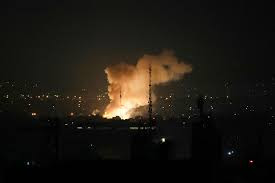On June 13, 2025, the long-simmering tensions between Israel and Iran erupted into open warfare, igniting a conflict that has plunged the Middle East into chaos and raised global fears of a broader regional catastrophe. What began as a preemptive Israeli strike on Iranian nuclear and military targets has spiraled into a relentless exchange of missiles, drones, and airstrikes, leaving hundreds dead, cities scarred, and civilians on both sides gripped by terror. As the war enters its second week, the world watches with bated breath, wondering if diplomacy can halt the descent into an all-out conflagration.
Iran retaliated hours later with Operation True Promise III, launching over 100 ballistic missiles and drones at Israeli military bases and cities. The barrage overwhelmed parts of Israel’s Iron Dome system, with strikes hitting Tel Aviv, Jerusalem, and Haifa. By June 17, Iran’s advanced Haj Qassem missiles, used for the first time, caused devastating damage in Bat Yam, killing civilians and shattering residential towers. “This is the first time Israel has faced a state with such a formidable arsenal,” said Al Jazeera’s Nour Odeh, reporting from Amman. Iran’s Supreme Leader Ayatollah Ali Khamenei vowed a “harsh response,” rejecting U.S. calls for surrender and warning that American intervention would bring “irreparable damage.”
As the war intensified, civilian tolls mounted. Iran’s health ministry reported 224 deaths by June 17, with 90% civilians, including 60 children in a flattened Tehran apartment block. In Israel, 24 civilians were killed, with 592 injured, as Iranian missiles struck homes and, on June 19, directly hit Soroka Medical Center in Beersheba, injuring 32. Israel’s Defense Minister Israel Katz called the hospital attack a “war crime,” while Iran claimed it targeted nearby military sites. Amnesty International urged both sides to protect civilians, condemning vague evacuation warnings—Israel’s to Tehran’s 19 million residents and Iran’s to Israelis near “vital areas”—as ineffective and reckless.
The conflict’s ripple effects have destabilized the region. Iran’s “Axis of Resistance”—Hezbollah, the Houthis, and Iraqi militias—has joined the fray, with Hezbollah launching rockets from Lebanon and the Houthis firing drones from Yemen. Israeli strikes have weakened these proxies, but threats of retaliation against U.S. bases in Iraq and Syria loom large. Oil prices surged to $78 per barrel, with fears of Iran closing the Strait of Hormuz pushing prices toward $100. Thousands of foreign nationals, including Chinese and Australian citizens, have fled Iran, while Japan and Australia shuttered their Tehran embassies.
U.S. President Donald Trump’s response has been erratic, veering from calls for peace to threats against Iran. On June 17, he demanded Iran’s “unconditional surrender” via social media, claiming to know Khamenei’s location but sparing him “for now.” Two days later, he announced a two-week window to decide on U.S. military involvement, raising fears of escalation. Reports suggest Trump vetoed an Israeli plan to assassinate Khamenei, but his administration is considering strikes on Iran’s nuclear sites, particularly Fordow, which requires U.S. bunker-busting bombs. “If we need to fly with Israel, so be it,” said Senator Lindsey Graham, reflecting hawkish sentiment in Washington.
Diplomacy remains elusive. Iran rejected ceasefire talks through Qatar and Oman, insisting negotiations cannot proceed under attack. European officials, sidelined by the conflict’s intensity, plan to meet Iranian counterparts in Geneva on June 20, but expectations are low. Russian President Vladimir Putin, while calling for de-escalation, noted Iran’s society is rallying around its leadership, complicating hopes for regime change—a goal Netanyahu has hinted at but not officially endorsed.
On the ground, fear defines daily life. In Tehran, residents like Dena, a 48-year-old mother, lament the lack of government guidance: “They don’t tell us where to go or how to stay safe. They just celebrate firing missiles.” In Tel Aviv, Tamar Weiss, clutching her infant daughter, described sleepless nights in makeshift shelters: “Our buildings are old, with no safe spaces. We’re terrified.” Internet blackouts in Iran, blamed on security measures, have left civilians cut off, while Israel’s censorship crackdowns target Palestinian citizens posting about the war.
As missiles streak across the skies, the Israel-Iran war teeters on the edge of catastrophe. Israel claims to have destroyed a third of Iran’s missile launchers and gained air superiority over Tehran, but Iran’s arsenal, though depleted, remains potent. With no clear off-ramp, the conflict risks drawing in global powers, threatening a war that could reshape the Middle East—and the world—for decades to come.





1 Comments
Interesting
ReplyDelete